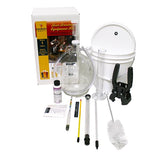Yeast Starters
Making a yeast starter for your beer has many benefits...
- Improved attenuation (lower final gravities).
- Less lag time before fermentation begins, as little as 3-4 hours. This helps reduce chances of infection.
- Cleaner tasting beer. Stress-free yeast produces fewer congeners.
- Highly recommended for brewing high gravity beers (beers with higher alcohol contents).
- Highly recommended for brewing lager beers. Due to cold fermentation, a higher yeast cell count is needed.
So, how to do it!... You will want to make your yeast starter 24-48 hours prior to brewing.
- Remove yeast from fridge so it can incubate to room temperature.
- Find either a 1/2 gallon growler, 1 gallon glass jug, 2000+mL Erlenmeyer flask, or 1 Qt. Mason jar.
- Clean and sanitize this starter vessel thoroughly!
- Boil 4 parts water to 1 part light dry malt extract (DME). So, 1/2 cup DME and 2 cups H2O. You may wish to add some yeast nutrient to your starter wort; do so according to directions on nutrient packaging.
- After boiling for 10 minutes, starter is sterile. Cover and chill to room temperature.
- Pour cooled wort into sanitized starter vessel. Pour through a sanitized funnel if necessary.
- Make sure the wort is between 68-75F, then add yeast to starter wort.
- Cover with foil or airlock and swirl often or place on a magnetic stir plate. After 24 hours, starter is ready to be pitched into 5 gallons of wort. Starters can be "stepped up" to create an even higher cell count by repeating the process but pitching starter culture, as opposed to a pack of yeast, into the new starter wort.
As always SANITATION IS CRITICAL!


